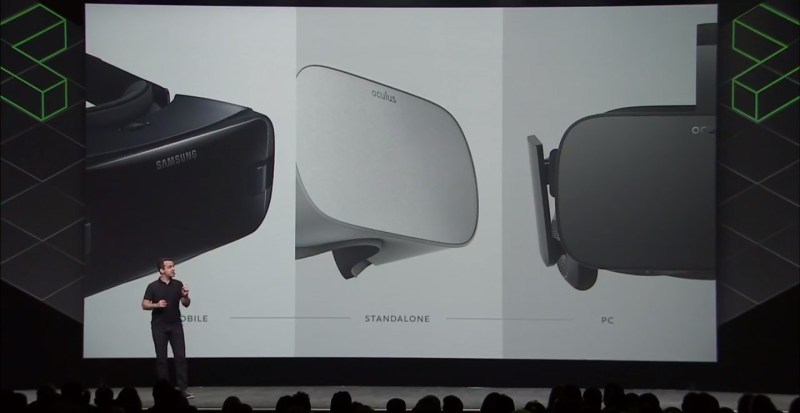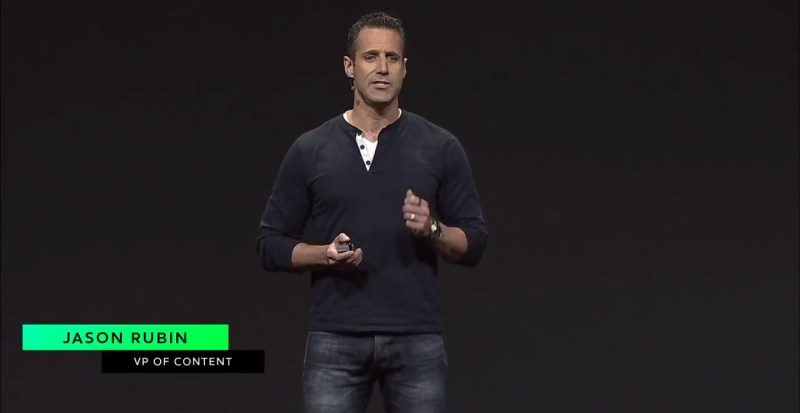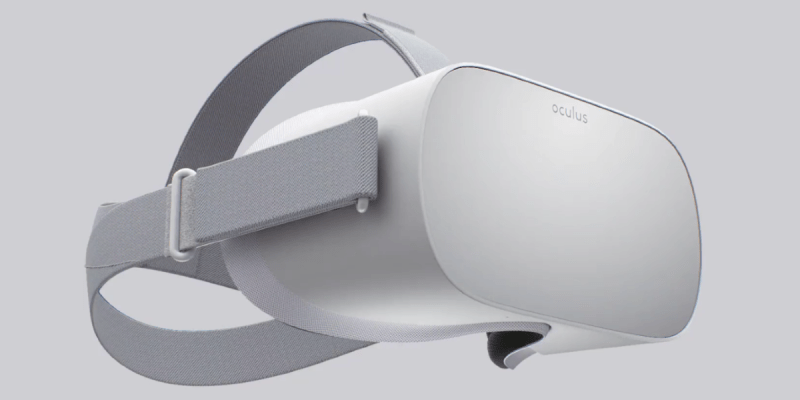
Above: Oculus Connect 4.
GamesBeat: How do you look at some of the stranger things that could be coming into the platform — haptics and all the things that could be in the holodeck? You start adding up lots of different types of accessories that could be thrown in. How do you look at that while also considering that you want this to be a platform for a wider group of people?
Rubin: You can see two ways of going about tackling this market. Our methodology is pretty simple. We believe Rift is a compelling device for a customer today. We want to fill that ecosystem with compelling software, get a large ecosystem of customers, and have the developers and the community grow as quickly as possible. Hence our focus on price, hence our focus on not trying to throw every bell and whistle we have out there, even though we have a lot of these ideas. Our goal is to make a mass-market consumer device that a developer can target and that a consumer can feel comfortable purchasing. That’s been our strategy.
On the other end, you have, “Let’s throw the kitchen sink at the wall, say VR’s not ready, say price points don’t need to come down, throw no money into software development whatsoever, dangle a lot of promises, and see if this ever works out.” I don’t like that latter way of doing things. I think you have an obligation to your consumer to give them a complete experience. Then, once they have the complete experience, it is totally worthwhile to attempt new things.
If somebody wants to try hand tracking, great. If somebody wants to go wireless, great. But to continue to raise the price of the device, never bringing it down, adding features, never creating an ecosystem of interesting content for people — I think that leads to a never-ending hardcore user group that’s really interested in the garage — what can I make? I want to put these things together and create a one-off experience that literally won’t work outside my garage. I don’t think that creates an ecosystem.
Our goal has been to make a much more concise, easy to understand, price-appropriate way of doing things. If a third party wants to come in and add to that ecosystem, well, we’ve been very open with our CAD on the headset. If someone wants wireless, that’s awesome. It doesn’t change the way things work. We love those peripherals. If one of them rises to the point where everyone says you have to have that, OK. That’s a good time to see whether this is additive and whether we should go to a second generation.
But the constant iteration of, “Here’s a new thing,” it messes up the market. It confuses the living daylights out of people. Frankly, if you’re not eventually delivering those things, I think it’s going to hurt the marketplace. There’s not a lot of delivery. There’s a lot of promises to these new ideas, but not a lot of delivery.

Above: Jason Rubin at Oculus Connect 4.
GamesBeat: At some point, I suppose you want to get to the glasses-on-your-face kind of thing. That seems to suggest bringing AR into the platform at some point. Do you have to shoot for that?
Rubin: The constant trade-off is new technologies and moving toward what we believe is the eventual future, which Mark has placed on his chart from last year as “glasses.” You have to change things to get to glasses because Rift is, by definition, not at the end of the chart. It’s not glasses. At the same time, if at every time you have something you could put in the marketplace, you’re putting it out and never supporting any of those additions with an ecosystem of content that people want to use, you’ll never get to glasses anyway because nobody’s going to buy any of it.
You have to iterate in reasonable chunks that the consumer understands. At every turn, you make sure the consumer is getting a quality experience that makes them say, “I had a great time for a number of years with that piece of hardware. I’ll trust you that the next time I upgrade to whatever bells and whistles you throw in your 2.0, it’s worthwhile.”
Again, there are two ways of looking at this right now in the PC ecosystem. We’re pretty diametrically opposed. If you look at the way consumers are reacting, it’s becoming clear which one is, for the mass market, making more sense.
GamesBeat: You have Microsoft coming in and seeding all these different hardware makers with mixed reality. How does that change the market versus previous entries like Sony and HTC?
Rubin: Well, we welcome the lower price point. That gets more people in VR. The next question will be, are they also supporting that ecosystem with a wealth of content and the other things that I just said we do? That remains to be seen.
I would also say, [Facebook vice president of VR Hugo Barra] stood up on stage today and made a very strong case for why a certain number of cameras is required to get a tracking volume that’s comparable to Touch. What we don’t want to do as a company, now that we’ve shown people how awesome Touch is, is take a massive step back and say that it’s not going to be as good as Touch when we go to inside out tracking.
You’ve done the Santa Cruz demo. You got Touch out there, right? Granted, this is not complete hardware. We’re still prototyping and working on improving it. But you can throw a ball behind you. Someone made a point of playing Superhot and trying to reach down and pick up something beneath them, which is a pretty big part of Superhot. You need to keep your eyes on things and move around like this. If you have a headset that doesn’t give you the capability to do that, that’s a step back. We believe, fundamentally, in Touch’s quality level, and we’re showing with Santa Cruz that it’s also possible with inside-out tracking.
GamesBeat: The only limitation with Santa Cruz is, do people have rooms big enough for it?
Rubin: It’s awesome playing in a big room. But the truth is, you could put Santa Cruz in a room on the scale of Rift gameplay, and it would work just as well. There’s no reason you can’t shrink the room. We’re obviously showing the power of Santa Cruz, and some people will want to do that. But there’s no reason you can’t take a game that has a smaller, constrained space.
Take, for example, Wilson’s Heart. In Wilson’s Heart, you basically stand behind a table and do things. You could do that with Santa Cruz. When you build that game, if this is my table, I’m just not going to do this because there’s no good reason to do it. Also, when you do that in Wilson’s Heart, it pauses the game. You go to skeleton. You see yourself, and it tracks you back. There’s no obligation to have a massive room for Santa Cruz. But regardless of the scale, you can still do this stuff and track your hands. We think that’s vitally important.

Above: Oculus Go.
GamesBeat: When we see the improved titles a year from now, are there some things you can predict about them? What kind of experiences are we going to see? What kind of quality should we notice?
Rubin: It’s all very incremental. Like I said on stage, no one really thought about how a hand should do this. To date, only Lone Echo has done this, and it is so much more immersive than when your hand goes right through things. A lot of little incremental steps are happening.
I also made the point on stage today — sometimes, it’s not the Lone Echoes and the Ready at Dawns, with large budgets, that shake things up. It’s the Dantes. It’s one person who says, “All of you are wrong. I’m gonna do my own thing.” And people love it. There’s a market there. I was wrong. That was a huge, huge win for Dante. Oculus had an opinion, Dante had a different opinion, and he found a market. That’s not to say there aren’t people who do want comfortable, no teleport. It’s better for certain types of people. But Dante proved that there’s a large audience out there that wants to do something else.
We’re going to rely both on our high-end, high-budget, extremely talented, large teams, as well as the small independent developers, to continually, incrementally make things better and more interesting. It’s those little things. Once one person figures this out, next year, you’ll see that in a bunch of titles. These things all roll together and become the language of making games in VR.

